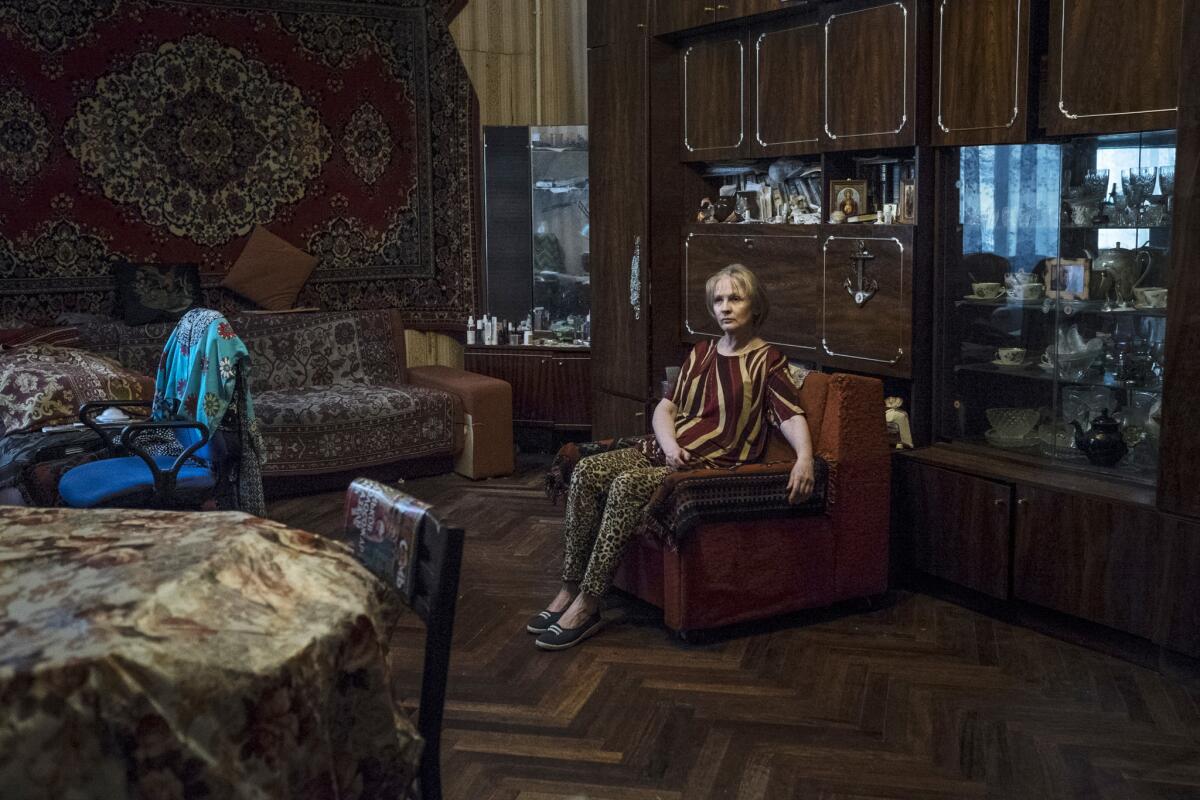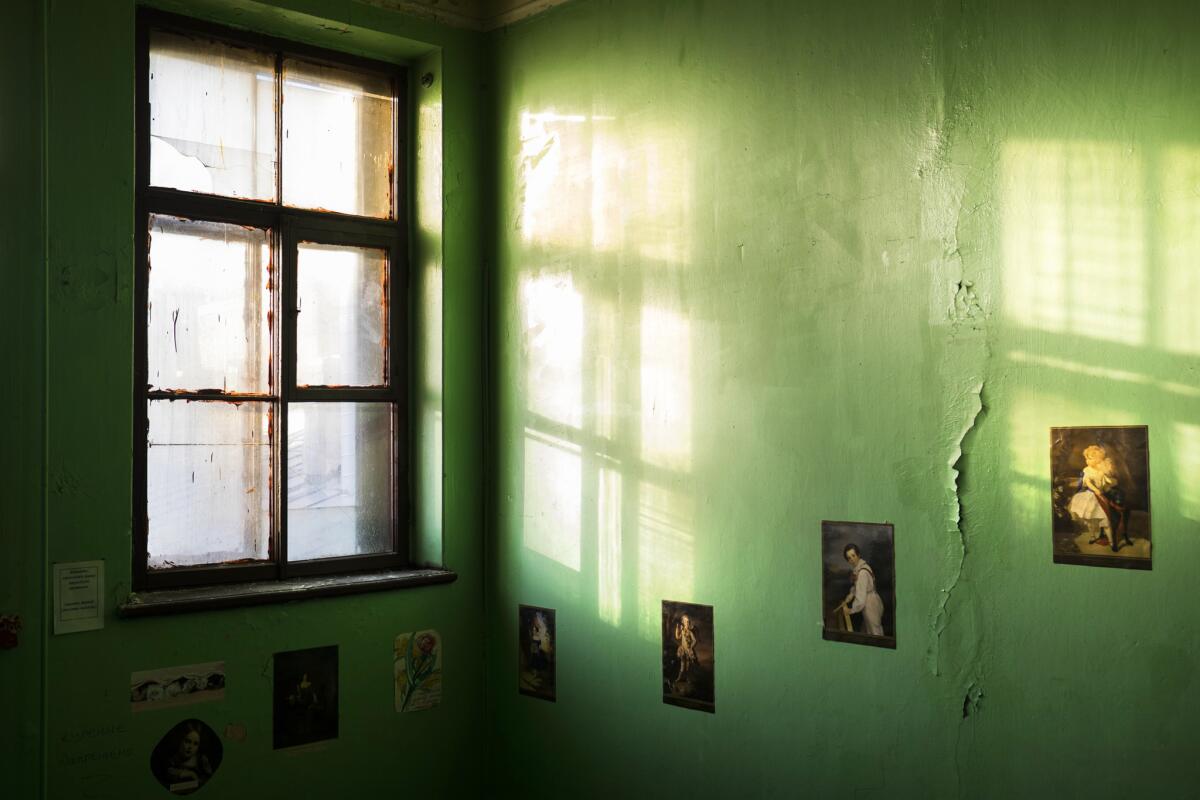On the Ground: In St. Petersburg, a stalwart of the 1917 revolution lives on: The communal apartment
By the time Marina Maslova was born in the six-room communal apartment at 65 Bolshoi Prospect, an entire generation had lived there and come of age since the 1917 Bolshevik Revolution.
Maslova still lives in the room where she was born 61 years ago, and she remembers the dozens of families that have walked down its twisting, dark hallways and lived in its crowded rooms during her life.
It was here that the guests at her wedding party in the 1970s moved the furniture aside to make room to dance in the 345-square-foot room she shared with her new husband, her parents and her grandmother.
And it was here, in a small room just off the kitchen, where a 16-year-old boy hanged himself with his belt in the early 1960s after his parents, with whom he shared the cupboard-size space, disappeared. Both the parents were deaf and mute, and the teenager, distraught about their constant drinking and neglect, took his own life out of despair, Maslova said.
“No one ever lived in that room after that,” she said.
One hundred years after the Russian Revolution, communal apartments like Maslova’s remain one of the enduring symbols of how this elegant city went from the Russian Empire’s grand capital to the heart of a communist revolution that would rattle Europe for the next 70 years.
With its palaces, streets of Italian-designed buildings and romantic canals, St. Petersburg was Peter the Great’s showcase city, which he said would be Russia’s “window to the West.”

But when the Bolsheviks overthrew the czar and established what would become the Soviet Union, they faced a housing crisis. Rural residents were flocking to St. Petersburg (renamed Leningrad), Moscow and other cities in search of economic prosperity. Meanwhile, the nobility and aristocracy were forced to flee or were killed. The communist government took over their elegant homes and apartments buildings and resettled displaced families with strangers in hundreds of thousands of apartments in St. Petersburg’s historical city center.
The shared apartments became known as communal apartments, or kommunalka in Russian.
In most cases, one family received one room in an apartment, which could be as small as three rooms and as large as 10. The family’s room served as a bedroom, dining room and living room.
In many cases, several generations lived in one small room, such as Maslova’s family did until 1988, when the woman in the room next to hers died, and the Soviet government allotted the empty room to the expanding Maslov clan.
“In that sense, the Soviet Union wasn’t that bad: They gave us apartments,” she said.
Today, the St. Petersburg city government estimates (link in Russian) that there are 250,000 people living in 78,500 communal apartments in the city of 4.5 million. That number is down from about 117,000 communal apartments in 2008, when the city first started a relocation program for families living in the most rundown of kommunalka.
Common space is shared and often fought over, including the use of the toilets. Each family has its own toilet paper roll and, in some apartments, its own toilet seats, which hang on walls and are taken down when needed.
Apartment 16 did not get hot water until 1986. Until then, there was no bathroom for washing up, just a kitchen sink, so residents went to the banya, the public sauna, down the street to bathe.
Shared kitchens can have as many as five stoves, and families rotate cooking and eating times to avoid conflict. Refrigerators and food supplies are kept in the family’s rooms.
The hallways are perpetually dark as there are no common lights. Electrical wires tangled in bunches drape from the hallway’s walls as they wind their way from room to room. Each family has its own electricity meter, and a lamp over the door to their rooms. Some apartments even have wired separate switches for the light over the toilet so that one neighbor isn’t having to pay for another neighbor’s visits.

When Maslova’s building was built in 1899, St. Petersburg was full of similar apartment blocks in which wealthy landlords rented the various-sized apartments to temporary and sometimes long-term residents.
Maslova’s grandmother received this apartment during the siege of Leningrad in World War II, when Nazi Germany’s troops surrounded the city for 900 days, depriving its residence of crucial supplies. Her grandmother had been living in a wooden house, but when it was torn down to be used as firewood, she was given one of the larger rooms in the apartment for her and her daughter.
At its peak, 17 people and six families lived in Apartment 16, Maslova said. Today, there are only about six or seven people, depending on who’s coming and staying. Students rent the rooms so that they can live and study in the historical center.
When relations are good among the neighbors, as they are in Apartment 16, the shared living situation is tolerable. When they are bad, life is very hard, Maslova said.
In the 1950s, Soviet leader Nikita Khrushchev introduced a massive urban housing project that built housing blocks across the Soviet Union. Tens of thousands of families living in communal units were moved out into their own apartments, many of them were outside the city center. In other cities, like Moscow, this largely ended the kommunalka. But in St. Petersburg, hundreds of thousands remained in the historical buildings in the heart of the city.
It’s not ideal; I’d like more quiet. But I get to live in the historical center and experience the city, so it’s worth it.
— Evgeniy Korelin, artist living in a communal apartment
After the breakup of the Soviet Union, real estate companies bought up huge swaths of communal apartments in St. Petersburg’s scenic center and turned them into luxury apartments or boutique hotels. Many kommunalka residents were eager to leave their shared dwellings for their own apartments, even if it meant living in large block housing outside the center.
“In St. Petersburg especially, people who feel themselves like real ‘Peterbourge’ feel that they can only live in the center,” said Ilya Utekhin, an anthropologist who did an extensive research project on kommunalka in 2008 and who grew up in one himself. “For this reason, many are willing to endure the poor conditions simply for the sake of remaining in the center.”
Evgeniy Korelin, 26, is an artist who bought one of the rooms in the apartment with his brother four years ago. They remodeled the interior and created a modern loft that lets in enough light for Korelin to work in his room. At 2 million rubles, or about $33,000, it was cheaper to buy a room in a communal apartment than to buy a larger apartment outside the center.
“It’s not ideal; I’d like more quiet,” he said. “But I get to live in the historical center and experience the city, so it’s worth it.”
The staircase leading to Lena Mikhaylovskaya’s kommunalka on Rimskogo-Korsakova Prospect has sunk and become uneven as the old building has settled with age.
Built in 1798, the three-story building in the heart of St. Petersburg is just blocks from the famed Mariinsky Theatre and was once the home of a vice governor of St. Petersburg. In the 1860s, it was converted into a seminary dorm and a fourth floor was added.
When the revolution came, the Bolsheviks turned the seminary into eight communal apartments, all of them containing at least 10 rooms. In St. Petersburg, the number of doorbells at the front entrance is a telltale sign that an apartment is a kommunalka. Mikhaylovskaya’s front door has five buzzers, not all of them functioning.
Mikhaylovskaya, her husband and teenage daughter share one room in the 10-room apartment. These days, it’s mostly students who are renting the rooms, so inside it’s mostly quiet, she said. The old building has thick walls that block most noise.
Apartments in this building have been hard to sell because of their size and the number of repairs needed to the old building’s crumbling infrastructure, Mikhaylovskaya said.
After years of living here as a young family, they’ve finally saved enough money to buy their own place and will move out in two months.
“Sharing space with other people … it’s just not what I want to do anymore,” she said. Mikhaylovskaya grew up in a four-room kommunalka. Growing up, it was so common to live in a communal apartment that Mikhaylovskaya had trouble thinking of one of her classmates who didn’t spend their childhood in one.
If you lived in the center, you probably lived in a kommunalka.
— Lena Mikhaylovskaya

For couples like Igor Zaitsev, 48, and Ksenia Belayeva, 40, the idea of selling their two rooms on Nevsky Prospect, St. Petersburg’s main drag, presents a dilemma. The couple has shared their three-room kommunalka with Svetlana Kosinova, 32, for 10 years. They have become family, even taken vacations together, Zaitsev said, pointing to a photo hanging on the kitchen wall of the three housemates in Prague, Czech Republic.
Selling their rooms would mean giving up a life they have grown accustomed to and some people might even envy, he said.
“And when you go away for a few days, there’s always someone around you can ask to feed the cat,” Belayeva said with a grin.
Twitter: @sabraayres
Start your day right
Sign up for Essential California for news, features and recommendations from the L.A. Times and beyond in your inbox six days a week.
You may occasionally receive promotional content from the Los Angeles Times.




